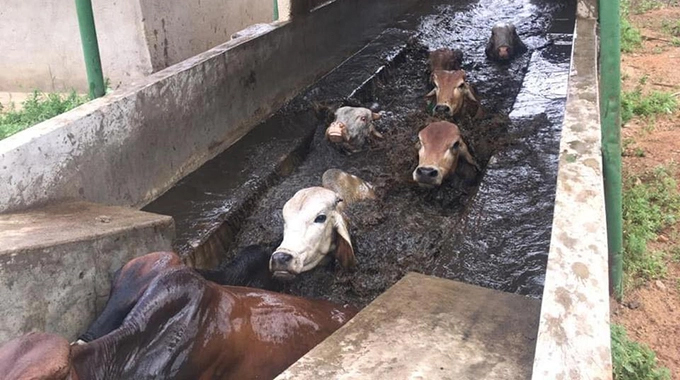
The ManicaPost

Samuel Kadungure
Senior Reporter
Since 2018, Manicaland has lost about 4 000 cattle worth millions of dollars to theileriosis — a ruthless tick-borne disease caused by irregular dipping.
This has dealt a lethal blow to thousands of communal farmers’ livelihoods.
However, the losses could be even more than this as some cattle deaths go unreported.
Four notorious tick-borne diseases —theileriosis, heart-water, babesiosis and anaplasmosis — are blamed for upto 65 percent of cattle diseases in the province.
However, theileriosis, or January disease, remains the biggest threat in the country, wreaking havoc even outside the usual peak rainy season.
This is mainly because only 70 percent of cattle are dipped regularly.
From January 2023 to date, about 4 500 cases of tick-borne diseases have been recorded in the province.
The highest number of cattle deaths is usually recorded between January and March when the tick population in pastures is high.
However, when dipping is strictly enforced and adhered to, animal health significantly improves.
The Department of Veterinary Services has now taken a tough stance to promote weekly cattle dipping in a bid to control the spread of the tick-borne disease.
Manicaland Provincial Veterinary Officer, Dr Charles Guri said communal areas in the province account for about 633 000 cattle that are served by 557 communal dip tanks of various carrying capacities.
He added that about 30 percent of the cattle are skipping dipping.
“During this wet season, tick-borne diseases to guard against include January disease which has been wreaking havoc in our communal areas, babesiosis, anaplasmosis and heart-water, which are the major causes of cattle mortalities in the province.
“About 65 percent of diseases that affect cattle are tick-borne diseases and if farmers follow the new calendar, it means we will reduce the chances of cattle falling sick by 65 percent.
“Dipping is a very important activity that we must carry out, and we will prosecute those who violate the provisions of the Animal Health Act by not availing their cattle for dipping.
“The importance of cattle in the communities cannot be underestimated and all efforts are being made to ensure that the provincial herd is in the best health possible,” he said.
Dr Guri also urged farmers to vaccinate their livestock against diseases like anthrax and lumpy skin which usually manifest in summer.
He said a large number of cattle are in the hands of resource poor communities where they are used for draught power and income generation.
This is why Government has intervened by resuscitating communal dipping and availing the required chemicals.
The Veterinary Department has also improved its surveillance services and is offering post-mortem services on dead livestock.
Said Dr Guri: “About 30 percent of the 633 000 cattle is not being brought for dipping, yet to ensure good health and productivity of cattle, regular dipping is paramount. It is one of the key elements to successful cattle farming.
“On average, we prosecute about five farmers per week, and fine them US$30 for every dipping session missed. We do this because if a proportion of cattle is not dipped regularly, it poses risk of providing hosts for ticks and other insects to complete their life cycle.
“This is why you find the disease curve going up. The cattle dying of tick-borne diseases are among those that are not being brought for dipping, ” he said.
The Department of Veterinary Services has enlisted the services of traditional leaders and the police to compel farmers to dip their cattle every week.
“Our dipping calendar has been adjusted according to the wet conditions and the frequency of dipping has increased to once a week because we want to reduce the infestation of animals by the ticks.
“If the encounter of livestock and ticks is high, chances of animals contracting infections are high. We have changed from once fortnightly to once weekly because we are coming from the dry season where the grass was dry with the activity of ticks and insects very low. During the wet season where we have a combination of intense rain and high temperatures, we have an increased activity of ticks and insects, leading to high transmission of tick-borne diseases,” he said.
Livestock specialist, Professor Joseph Kamuzhanje said farmers need to preserve the provincial herd.
“Each livestock death must be followed by a post mortem, and this is how diseases are tracked. The rules and regulations of dipping must be judiciously enforced. Nowadays the law seem to be a bit relaxed. The tick-borne diseases are still the same, but the difference is on how they are being managed.
“In the past, the movement of animals was properly restricted, but nowadays a person can just relocate cattle from one point to the other. Regulations should be tightened to control disease outbreaks,” he said.
A farmer who refuses to avail their cattle for dipping will be breaking the Animal Health Act, which was promulgated in 1960.
The Animal Health (Cattle Cleansing) Regulations (1993) also makes it mandatory for farmers to avail their cattle for dipping whenever the Department of Veterinary Services deems it necessary, and those who do not comply are liable to prosecution.
The regulations stipulate that no person shall fail or refuse to comply with a lawful instruction to dip their cattle.
Dipping is a broad spectrum method of parasite control that can control scab, ticks, lice, blowfly, and keds with one product.
Methods of dipping cattle include spray race, pour-on, hand spraying and belly baths.
A plunge dip is a construction that allows complete immersion of livestock in a liquid that contains a parasiticide.
This ensures that the animal is completely submerged in the chemical on areas such as inside the ears and under the tail where ticks are found.



